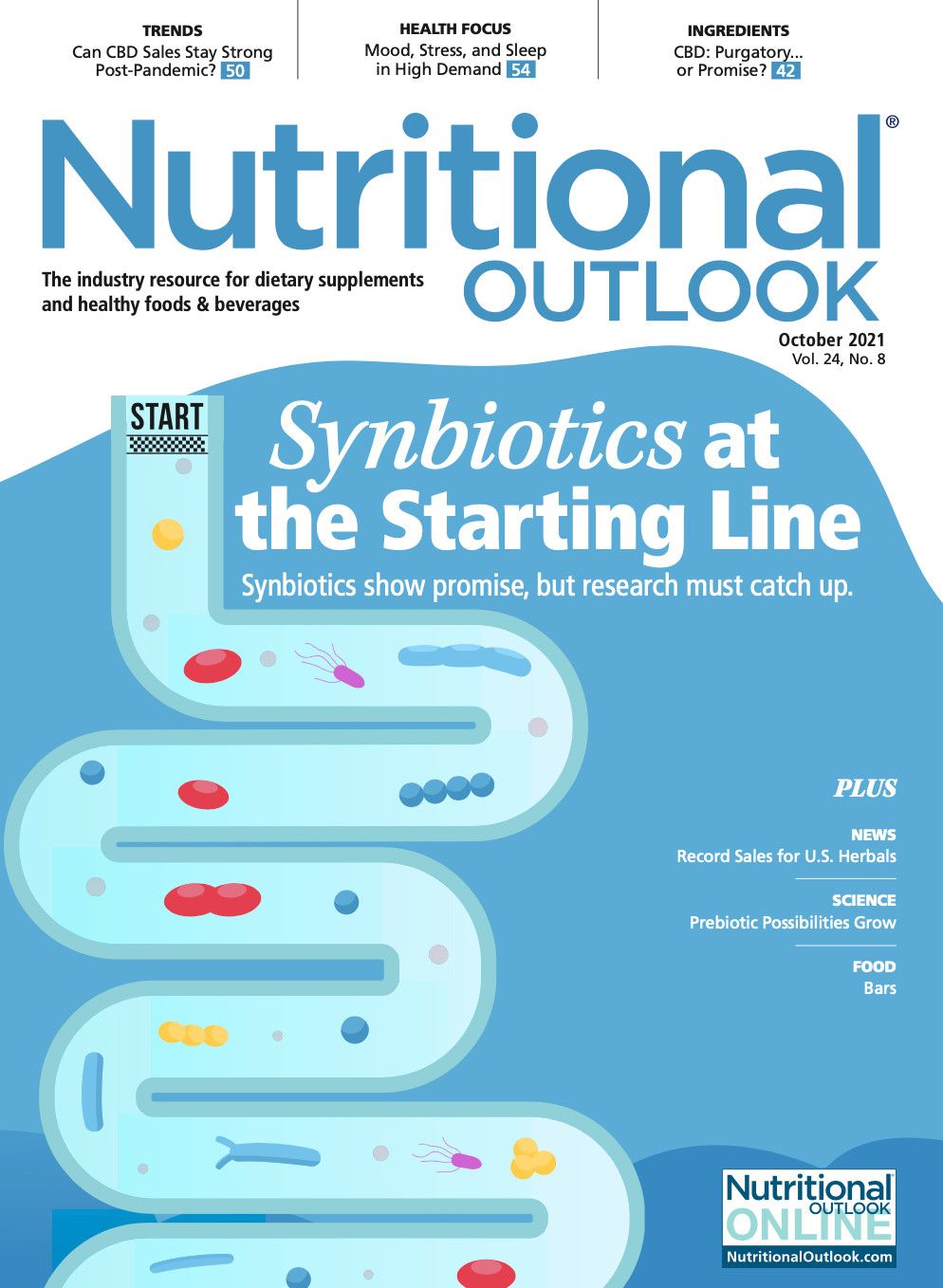Synbiotics at the Start: More research will make the synbiotics category easier to digest
The market is primed for gut health formulations that offer the best of both worlds. But research needs to catch up.
Photo © Rudzhan - Stock.adobe.com

It’s no secret that immune health and, by association, gut health are top of mind during the COVID-19 pandemic. The good news is that it’s a trend with staying power: the U.S. digestive health supplement market is projected to grow at a CAGR of about 7% between 2021 and 2026.1
In the midst of this growth is the emergence of a burgeoning category: synbiotics, or formulations containing both live bacteria (probiotics) and compounds that feed bacteria (prebiotics). Some synbiotics are complementary, meaning the probiotics and prebiotics work independently in a formulation; others, however, are synergistic, meaning that the prebiotics are selected specifically to benefit the chosen probiotic, yielding a more significant combined benefit.
Consumers are on board, and Innova Market Insights says that globally, new synbiotic launches grew an average of 41% annually between 2016 and 2020. Why? Despite being a relatively new category, synbiotics benefit from existing consumer understanding of probiotics and prebiotics. In fact, 2021 research from the Global Prebiotic Association shows that 47% of prebiotic users already look for a synbiotic (even if they don’t use that language) when purchasing prebiotics at retail. “Part of this is overall convenience,” says Len Monheit, the association’s executive director. “The rest is realizing that probiotics work optimally with complementary prebiotics.”
Research Hurdles
Though the health benefits of probiotics and prebiotics are extensively substantiated by research, the same cannot yet be said for synergistic synbiotics. In addition to simply being a newer category of supplements, synergistic synbiotic research is complicated by the fact that probiotic research is largely conducted on bacteria blends rather than individual strains, explains Asma Ishaq, CEO of the brand Modere (Los Angeles). “That means more research needs to be conducted to find the right prebiotic pairing for each beneficial bacteria strain,” she says, before scientists can even begin to study the combined benefits of the synbiotic. But the hurdles don’t end there.
As is the case with testing multi-ingredient formulations, synbiotic research also requires more complicated exclusion criteria (due to potential concomitant therapies) as well as more extensive known or theoretical adverse event profiles, which must take into account both individual ingredients and combinations of ingredients, explains Joshua Baisley, vice president of clinical design and delivery at contract research organization Nutrasource (Guelph, ON, Canada).
Proving efficacy is just one part of it. If brands want to use claims on pack, even more research is necessary. “For synbiotics, there are currently no approved health claims due to the limited number of robust clinical studies that focus on synbiotics, compared to those that study prebiotics or probiotics alone,” explains UK-based Clasado Biosciences research and development director Lucien Harthoorn, noting that while the synbiotic field is a huge and very promising commercial area, it is far behind pre- and probiotics when it comes to clinical evidence. “To maintain the upward momentum of synbiotics,” he says, “there is a high need to plug these gaps in the coming years.”
Filling the Gap
Recently, Deerland Probiotics & Enzymes (Kennesaw, GA) conducted a clinical trial comparing the effect of Bifidobacterium lactis alone with that of a B. lactis PreforPro combination. PreforPro is the company’s prebiotic bacteriophage “cocktail,” which is active at a low 15-mg dose—important for brands that want to avoid making consumers take multiple servings per day. “The results demonstrated that the synbiotic was able to provide larger beneficial changes in the gut microbiota and improve GI symptoms to a greater extent than the probiotic alone,” explains Sam Michini, Deerland’s vice president of marketing and strategy.
Additionally, recent research from the supplements brand Regular Girl (Minneapolis, MN) shows that its synbiotic formula—a combination of Sunfiber prebiotics and B. lactis probiotics—may improve the bioavailability of nutrients. In this study, specifically, researchers examined the synbiotic’s effect on the uptake of iron supplements. Participants taking the synbiotic saw their iron markers rise 41% after four weeks; the placebo group’s levels showed no response. By the end of eight weeks, the synbiotic group’s levels nearly doubled.
“Synbiotics are products that rely on the ideal pairing of pre- and probiotics,” says Ishaq at Modere. “Only a small portion of the market meets this important criteria, leaving massive potential for growth.”
Designing a Synbiotic Study
If you ask Bob Hutkins, founding scientist at Synbiotic Health (Lincoln, NE), most current synbiotic research focuses on a prebiotic with its own benefits combined with a probiotic with its own benefits. What would be more valuable, he says, is research that can prove a benefit greater than that of the two components individually. Not only will this provide the clinical substantiation needed for synergistic synbiotic claims, but it will also address one of the biggest challenges in probiotic and prebiotic research: non-responders.
“One reason for non-responders may be that the person lacks the nutrients (prebiotics) that the specific probiotic requires to exist in the gut,” Hutkins says. “A well-designed synbiotic provides the probiotic with the prebiotic nutrient that allows it to exist and thrive within the gut.” His suggestion? Four-arm studies examining effects in control, probiotic, prebiotic, and synbiotic groups.
Indeed, one of the barriers to supplement usage overall is that consumers don’t “feel” an immediate difference. In the gut health space, synergistic synbiotics have the chance to address this barrier.
“People may have tried probiotics and prebiotics separately, and they did not deliver the benefits they expected,” says Jason Bush, co-chair of the International Probiotics Association’s Scientific Committee and chief scientific officer at Canada-based MSP Starch Products Inc. “This may be because the probiotic and prebiotic were not matched for each other.” A well-formulated, research-backed synbiotic would remove this guesswork for a better consumer experience.
Game-Changing Potential
Going forward, potential exists for postbiotics to play a role here, as well. “The goal—which we believe is achievable—is to create an ultimate microbiome-modulating product that uses the prebiotic to support the establishment and growth of good bacteria, the probiotic to seed the gut with beneficial bacteria, and the postbiotic to lead out in providing high concentrations of the beneficial metabolites produced by probiotics and good commensal bacteria,” says Michini.
Cashtyn Lovan, marketing manager at Cargill Health Technologies (Ankeny, IA), says the future also holds potential for the definition of synbiotics to include prebiotic/postbiotic formulations where the usage of probiotics is impossible due to stability concerns.
The bottom line is, with the right research, the synbiotic market’s potential is virtually limitless. “We’ve only scratched the surface of the microbiome,” says Ishaq. “There’s a ton of research still to be conducted, especially into personalization, because everyone’s microbiome is so unique.”
Reference
- Mordor Intelligence report. “United States Digestive Supplements Market – Growth, Trends, COVID-19 Impact, and Forecasts (2020-2025).” Published February 2021.

Polyphenols: The next generation of prebiotics is ready for liftoff
April 21st 2025Explore the prebiotic health benefits of polyphenols and the positive impact they may have on digestive and immune health. Polyphenols, such as those found in European black elderberry, may be an ideal solution for manufacturers trying to break into the digestive health space.

























